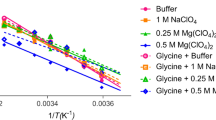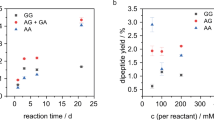Abstract
WE have been concerned with the isolation of acid phosphatases (orthophosphoric monoester phosphohydrolases, 3.1.3.2.) in quantities sufficient for chemical studies of these enzymes. The sources chosen were: the potato, the human prostate gland and human seminal plasma. We have found that the potato is a poor source and, although the enzyme has been obtained in a form which is homogeneous to starch-gel electrophoresis and to ultracentrifugation, the method is tedious and, because of the very large purification factor involved (about 25,000), leads to a low final yield (about 10 mg from 50 kg of potatoes). The best preparation previously reported was apparently associated with a purification factor of about 1,000 (ref. 1).
This is a preview of subscription content, access via your institution
Access options
Subscribe to this journal
Receive 51 print issues and online access
$199.00 per year
only $3.90 per issue
Buy this article
- Purchase on Springer Link
- Instant access to full article PDF
Prices may be subject to local taxes which are calculated during checkout
Similar content being viewed by others
References
Andreu, M., Fernandez Alvarez, E., and Lora-Tamayo, M., Anales real soc. espan. fis y quim. (Madrid), 56B, 67 (1960).
Hudson, P. B., and London, M., Arch. Biochem. Biophys., 46, 141 (1953).
Boman, H. G., Arkiv Kemi, 12, 453 (1958).
Shulam, S., Mamrod, L., Gonder, M. J., and Soanes, W. A., J. Immun., 93, 474 (1964).
Author information
Authors and Affiliations
Rights and permissions
About this article
Cite this article
VERNON, C., GAULDIE, J., HANSON, J. et al. Acid Phosphatases. Nature 208, 382–383 (1965). https://doi.org/10.1038/208382b0
Issue Date:
DOI: https://doi.org/10.1038/208382b0
This article is cited by
-
Fluorometric and colorimetric quantitative analysis platform for acid phosphatase by cerium ions-directed AIE and oxidase-like activity
Analytical and Bioanalytical Chemistry (2024)
-
Indications for a dimeric structure of an acid phosphatase in the lamprey (Petromyzon fluviatilis L.)
Biochemical Genetics (1973)
-
Discelektrophoretische Differenzierung saurer Phosphatasen verschiedener Herkunft
Zeitschrift für Rechtsmedizin (1971)
-
�ber die Verwendung von o-Carboxyphenylphosphat zum Nachweis saurer Phosphatase im Sperma
Deutsche Zeitschrift f�r die Gesamte Gerichtliche Medizin (1969)
Comments
By submitting a comment you agree to abide by our Terms and Community Guidelines. If you find something abusive or that does not comply with our terms or guidelines please flag it as inappropriate.



